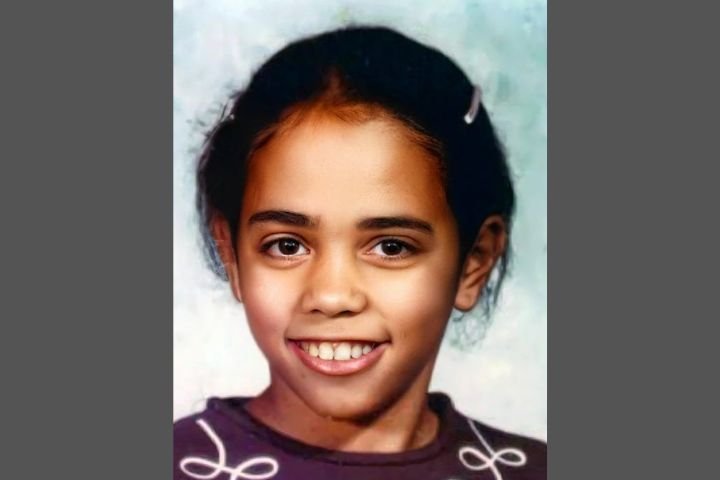The Disappearance of Pepita Redhair

Pepita Redhair had lunch with her mother, Anita King, on the afternoon of Tuesday, March 24, 2020. Afterward, Anita dropped Pepita off at her boyfriend’s home in Albuquerque, New Mexico, about a two-hour drive from their family home in Crownpoint. As Pepita got out of the car, she turned back to her mother and said, “Mom, I love you. Take care of yourself. Drive home safely.” The 27-year-old gave Anita a final wave and went inside. Anita had no idea it would be the last time she’d ever see her daughter.
Pepita had been living with her boyfriend, Nicholas “Nick” Kaye, and his parents for more than three years. Despite that, she stayed in close contact with her family and visited them often. “She always called me every day, saying, ‘Mom, what are you doing? What are you up to? Do you need anything?’” Anita recalled. Pepita also texted “goodnight” every evening — it was completely out of character for her to go even a day without contact.
When Anita didn’t hear from her daughter on Wednesday, her instincts told her something was wrong. She texted Pepita asking if she was okay but got no reply. As hours passed with no response, Anita’s concern turned to panic. By Thursday, she was frantic.
Anita finally reached Nick on Friday and asked where her daughter was. Nick claimed he had no idea — he said the two had argued at a house party Thursday night and that Pepita had left with another man. Anita didn’t believe him; she knew her daughter would never disappear without letting her know.
That same day, Anita received a text from Pepita’s phone — but it wasn’t from Pepita. A man said he’d recently bought the phone from someone else and didn’t know her. Anita immediately feared that the phone had been stolen or taken by someone who hurt her daughter.
Terrified, Anita called the Albuquerque Police Department (APD) to report Pepita missing. Shockingly, officers refused to act. “The cops just brushed it off,” Anita said. “They told me she’s an adult, free to travel, free to go missing. I was pretty upset.” She tried to explain that Pepita wasn’t the type to stay out of contact, but police told her to wait “a week or two” and call back if she still hadn’t returned.
Anita and Pepita’s sister, Shelda Livingston, were furious and disheartened by the lack of concern from APD — especially since they knew there was a history of domestic violence between Nick and Pepita. Just six weeks before she vanished, Nick had assaulted her so badly that she was hospitalized. Police had responded to that incident, yet now seemed uninterested in questioning him at all.
Worried that Nick might be holding Pepita against her will, Shelda drove to his cul-de-sac home and called out for her sister. The only response came from barking dogs. Shelda saw a curtain move, as if someone was watching her, but no one came out. Defeated, she drove home.
Anita next contacted the Navajo Nation Police in Crownpoint, hoping they could help, but they said they had no jurisdiction since Pepita was last seen in Albuquerque. They referred her back to APD.
When Anita called APD again, officers were dismissive. “They said my daughter was a drunk,” Anita recalled. “They assumed she left voluntarily and wasn’t important.” Anita believed their indifference was rooted in systemic racism. “Us Native Americans are pushed away. Our voices are not taken seriously.”
Desperate for help, Shelda reached out to local news stations asking them to share Pepita’s picture. None were interested. “That’s when we realized — we’d have to do this on our own.”
The family printed missing-person flyers and hung them across Albuquerque, especially near bus stops since Pepita didn’t drive. They also went door-to-door in Nick’s neighborhood. Neighbors described Pepita as kind and friendly, but none had seen her since her disappearance.
Two weeks later, the family organized a search in Albuquerque’s West Mesa area, scouring the desert outskirts where they feared Nick might have dumped her body. They asked police to use cadaver dogs — their request was denied. Instead, they searched on foot, opening garbage bags with sticks, dreading what they might find. Nothing led them closer to Pepita.
Nearly a month later, on April 19, Nick finally went to police and filed a missing-person report. He claimed the last time he saw Pepita was March 26, saying they argued at a party and she left on foot with a man named Laramy. He added that he later got a text from Pepita’s phone saying she was with another man and wasn’t coming back — and claimed it “sounded like her.”
Police accepted his story without question. Nick was never re-interviewed and was ruled out as a suspect. They didn’t even attempt to find or question Laramy.
Anita was furious. “They didn’t do a proper investigation. They never interviewed the family or the boyfriend.” Still, she refused to give up. “Even if I have to foot search on my own, I’ll do it. I need my daughter home.”
The family posted about Pepita’s case on Facebook, hoping to reach Laramy. It worked — he reached out himself. He said he knew Pepita but last saw her on March 10, two weeks before she disappeared. It was his birthday, and Pepita had given him a cupcake. Nick got angry when she sang “Happy Birthday,” and according to Laramy, he hit her. Laramy said he left immediately and never saw her again.
If true, that meant Nick had lied to police — Pepita couldn’t have left with Laramy on March 26. Yet investigators never followed up. Soon after speaking with Anita, Laramy died, and the lead was lost.
Despite constant calls from Anita, APD did little. They blamed COVID-19 restrictions, saying they couldn’t conduct in-person interviews — yet they didn’t even do phone ones. Anita and Shelda kept searching alone.
In May 2020, Shelda received a tip that Pepita had been seen at City Park in Albuquerque. She rushed there but found nothing. Later, she noticed several men with walkie-talkies and vans with tinted windows near a hotel parking lot — she suspected possible human trafficking but had no evidence.
At the end of May, Anita retrieved Pepita’s belongings from Nick’s home. Shelda brought some of her clothes to a Navajo medicine man, who performed a ceremony. He told her Pepita was alive but being held somewhere against her will — a painful but hopeful message.
In June 2020, Shelda received another sighting tip near a supermarket, but it turned out to be a lookalike. Months passed with no real progress. By March 2021, a full year later, police still hadn’t conducted even basic investigative steps.
Anita’s anger peaked in September 2021, when the case of Gabby Petito dominated national headlines. While Anita felt compassion for Gabby’s family, she was heartbroken that Pepita’s case — and so many missing Indigenous women — received no attention. “It was unfair,” she said.
Just weeks later, tragedy struck again: Anita’s husband, Pepita’s father, passed away. “He didn’t get closure,” Anita said tearfully. “I promised him we’d find our daughter.”
Determined, the family organized a rally on October 3, 2021, at Tiguex Park in Albuquerque. The Missing and Murdered Indigenous Women (MMIW) movement joined in, and families of other missing Native women shared similar stories of being ignored by law enforcement.
Bernalillo County District Attorney Raúl Torrez attended and said, “We owe it to one another to do everything we can to make sure these women come home.” He took over Pepita’s case.
The D.A.’s office did what police should have done long ago — filing warrants for phone records, gathering electronic data, and entering Pepita’s DNA profile into the national database for comparison with unidentified remains.
“We remain optimistic,” Torrez said, “but a year and a half is a very long time.”
Anita was thankful but frustrated by the lack of updates. “They say it’s confidential because the case is still active,” she explained. “But it’s hard being kept in the dark.”
In October 2022, authorities announced a $2,000 reward for information leading to Pepita’s whereabouts. Her family still believes someone knows what happened and hopes the reward will bring answers.
Anita continues to speak publicly about missing Indigenous women. “I hope they hear our cry,” she says. “We want to be taken seriously.”
🕊️ About Pepita Redhair
Pepita Redhair was 27 years old when she went missing from Albuquerque, New Mexico, in March 2020. She was a joyful young woman with an infectious laugh who loved skateboarding, drawing, and cooking. She dreamed of becoming an engineer or a teacher and was taking classes at a local community college while working part-time at Hot Topic.
Pepita has brown eyes and brown hair, stands 5’1″ tall, and weighs around 140 pounds. She has several tattoos:
- A dinosaur on her right forearm
- A koi fish on her left forearm
- A moon on her left leg
- A butterfly on her shoulder
If you have any information about Pepita Redhair’s disappearance, please contact the Bernalillo County Sheriff’s Office at (505) 222-1101.




